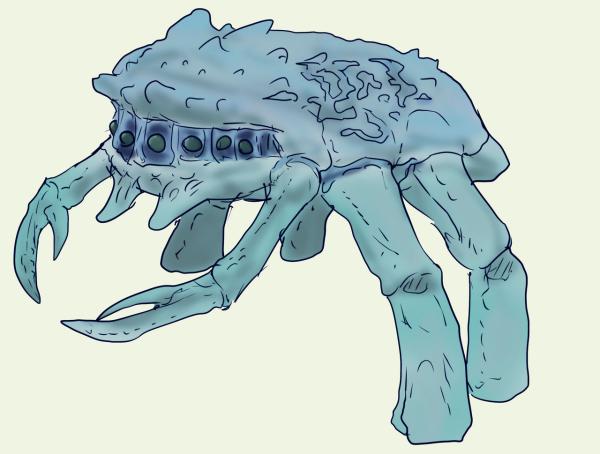BY LETTER
Muuh Clade Variation
 Image from Jason Roberts | |
| Muuh found on worlds with moderate or high gravity are generally much more robust, but otherwise retain most of the same body plan as their lighter cousins | |
Muuh diversity is significantly lower than that of Terragens, at least among the Muuh encountered so far. Psychologically, toposophically, and genetically the Muuh are quite evidently a single interfertile species, less variable from colony to colony in their underlying genome than the regional varieties of human baselines on Old Earth were. The basic morphotype does show some variations according to the environment that they live in, with forms adapted to differing gravities or temperatures and to slight changes in atmospheric composition or pressure. For instance there are spidery low-gravity forms found on a slowly rotating hab or on a typical Titan-like moon and stockier forms found in higher-spin habs or on planet-sized bodies. However, those physical differences all seem to be epigenetic responses that are part of the basic Muuh genome; all morphological and physiological variability is the result of growth and development in that particular environment. These adaptations seem to be the minimum required for health and survival in local conditions, and do not include such radical changes as, say, differing numbers of limbs. The Muuh do show some considerable cultural variation, but again this is not different than that found within a typical Terragen clade or a naturally evolved sophont species.
Unlike the case with humans, there are no Muuh equivalents of tweaks, splices, cyborgs, or superiors, or other varieties with significant departures from the Muuh morphotype and psychology. The Muuh have also apparently refrained from giving rise to artificial clades such as sophont ais, neogens, or vecs. The Muuh have created provolves in the past, but only rarely and sporadically. It is notable that they have not done so with any of the species that have Muuh-like biochemistry and genomics but instead all of their known work has been with radically different subjects: ammonia-based species like the Soft Ones, or species from the even hotter, water-based biochemistries such as HIE300CZE. When questioned regarding this, Muuh 'historians' will say such things as "we used to do that but we gave it up". The particular reasons why have never been clearly articulated.
 Image from Steve Bowers | |
| A clade of gracile low-gee Muuh from YTS-34410-1001-11 compared to a clade of robust Hi-gee Muuh from JD799810-cII | |
The uniformity of the Muuh physiotype and toposophic type has been cause for much speculation. The simplest hypothesis is that the Muuh change very slowly and that all current Muuh are descendants of a single surviving population of a civilization that might have been much more diverse. Others assert that the Muuh observed today are the result of many millions of years of self-modification, or that they are the creations of an earlier sophont species, and that over that time only the stablest type, least likely to further self-modify, has survived. It is thought that the truth regarding this falls under some form of Muuh Taboo: Muuh who bother to respond to Terragen speculations typically enthusiastically affirm all hypotheses.
 Image from Tharsis13 | |
| a clade of robust Hi-gee Muuh from JD909720-eIII | |
Related Articles
- HIE-300-CZE (The Bad Idea)
- Muuh Architecture
- Muuh Archives
- Muuh Cellular Biology
- Muuh Cyberspaces
- Muuh Historifics
- Muuh Iceship
- Muuh Pylons
- Muuh Taboo
- Muuhformer Minds
- Muuhian Epoch - Text by M. Alan Kazlev
Local (Perseus-Outer Orion) historical epoch characterized by the Muuhian interstellar civilization; 1.2 to 0.6 mya. Approximately equivalent in time to the middle Pleistocene of Old Earth. The Muuhian Epoch was followed (after a long period of time) by the Auldlimnerian Epoch. - Muuhome
Appears in Topics
Development Notes
Text by Stephen Inniss
Initially published on 15 March 2016.
High gravity muuh by Tharsis13 added January 2025
Initially published on 15 March 2016.
High gravity muuh by Tharsis13 added January 2025






